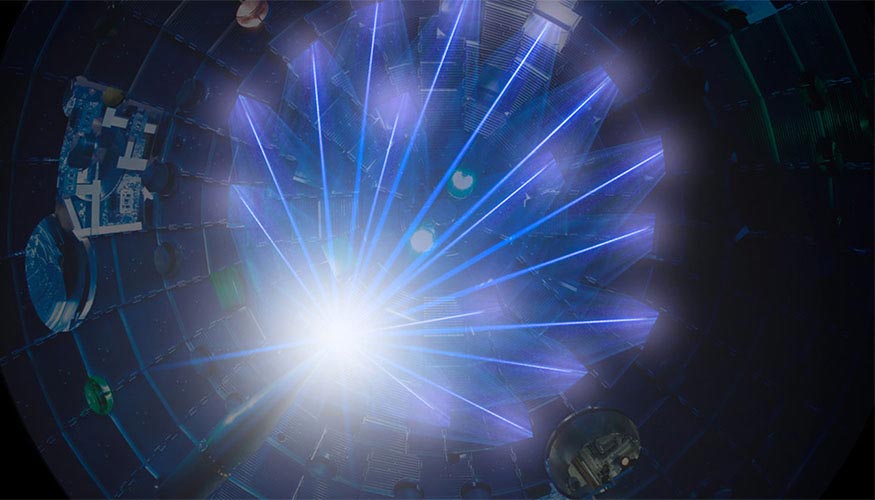

The high-energy laser beams from NIF converge on a target in the center of the target chamber. Success in achieving fusion ignition would be an important step forward in the pursuit of safe, carbon-free fusion energy. Credit: DOE
An influential Department of Energy (DOE) advisory committee has recommended that the country proceed aggressively toward the deployment of fusion energy, including investment in technology and equipment in support of one of the core missions of LLNL’s National Ignition Facility ( NIF) – lay the foundation for the development of inertial fusion energy (IFE).
The report, Powering the Future: Fusion & Plasmas, was published in December by the Fusion Energy Science Advisory Committee (FESAC). It was quickly followed by a February report from the National Academies of Sciences, Engineering and Medicine (NASEM) calling for aggressive action to build a US pilot fusion power plant as soon as possible in 2035.
The FESAC report, which is two years in the making, provides a ten-year vision for U.S. fusion energy and plasma science under the Fusion Energy Sciences (FES) program of the DOE Office of Science. NIF & PS physicist Tammy Ma, a member of FESAC and the report’s subcommittee, said LLNL was a key participant in the plasma physics community planning process that laid the groundwork for the report’s 10-year strategic plan.
Both the FESAC and NASEM reports focus on the development of magnetic fusion energy (MFE) technology, illustrated by the ITER experiment in France; the United States is one of 35 countries participating in ITER, which is more than 70 percent complete and aims to have the first plasma operations in 2025.
However, the reports recognize the need to simultaneously pursue other government and private fusion technologies, including IFE, and the FESAC report notes the “tremendous progress” NIF has made in ignition. Both reports call for partnerships with federal, international and private investors and outline opportunities for growth in fusion and plasma research, which NIF is attentively pursuing (see “10-Year Report Highlights NIF’s Contributions to Plasma Science”).
“FES has historically funded MFE research in the US, formerly IFE, and supported academic high-energy density physics research in the US,” said Ma. “While the total amount that LLNL receives from FES each year is small compared to what we receive from NNSA (the National Nuclear Security Administration), the path that FES maps has always had a major impact on the trajectory of fusion and plasma research in the lab. .
“This report now sets out a strong and coordinated fusion energy and plasma science plan for the next 10 years in the US, and LLNL is playing an important role,” she said.
The FESAC report contains recommendations for FES and priorities for a research and technology development portfolio under three budgetary scenarios: constant, modest (2 percent) growth and unlimited growth.
Points and recommendations in the report that are relevant to LLNL’s work include:
- Restart an IFE program even in the no growth scenario.
- Continue robust funding of the High Energy Density Laboratory Plasma (HEDLP) program co-sponsored with NNSA.
- Complete the Matter’s design and construction in extreme conditions
- (MEC) upgrade at SLAC National Accelerator Laboratory, which supports LLNL.
- Coordinate a High Intensity Laser Research Initiative (FES in collaboration with other federal agencies).
- Continue development of a multi-petawatt (quadrillion-watt) laser facility and a US high repetition rate, high intensity laser facility similar to the High-Repetition-Rate Advanced Petawatt Laser System (HAPLS) designed and developed by the NIF & PS Advanced Photon Technologies program; HAPLS was delivered to the Extreme Light Infrastructure Beamlines Facility in the Czech Republic in June 2017.
- Strong LaserNetUS support, with aggressive upgrades when budgets allow; LLNLs Jupiter Laser Facility is a member of LaserNetUS, an effort to restore high-intensity laser research in the US
- Aiming for a fusion pilot plant in the US by 2040.
- Pursue strong alternative and innovative fusion concepts.
- Build and design a medium-sized Z-pinch pulse power supply, preferably in collaboration with other agencies; LLNL is currently developing a number of advanced diagnostics for the Z machine at Sandia National Laboratories.
- Provide support for a robust public-private partnership program.
“Even under a constant budget scenario,” said Ma, “provisions are made to ensure that these activities are supported in some way. No new facilities can be built, but it is recommended to pursue pre-conceptual design activities and technological development. “
The DOE-sponsored NASEM report, Merger to the US grid, outlines the scientific and technical innovations required for fusion to play a role in the timely transition to a low-carbon economy by 2050. The NASEM plan calls for the production of a pilot plant design by 2028 and the addition of fusion energy to the electrical grid in the timeframe from 2035 to 2040.
Virtually inexhaustible fusion energy could provide a source of clean, carbon-free basic electricity for the US grid, the report said, playing a key role in decarbonising electricity generation infrastructure. Fusion uses abundant hydrogen fuels and does not create long-lived or high-level radioactive waste. It is inherently safe and ideally complements other renewable energy sources.